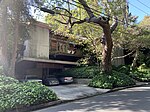Old Santa Monica Forestry Station

The Old Santa Monica Forestry Station is the nation's first experimental forestry station, built in 1887. The Old Santa Monica Forestry Station was designated a California Historic Landmark (No.840) on March 20, 1970. Old Santa Monica Forestry Station is located at Rustic Canyon in Los Angeles in the Santa Monica Mountains of Southern California in Los Angeles County. The site is south of what is now called Santa Monica Mountains National Recreation Area. In 1971 the state placed a marker near the entrance of the Rustic Canyon Recreation Center at the NW corner of Latimer and Hilltree Roads, at 601 Latimer Road, Los Angeles, CA 90402. This location is in what is now called Pacific Palisades. The hills and canyons around the Santa Monica Canyon were a land boom in the late 1880s. Abbot Kinney (1850-1920), from New Jersey, was a land developer and a conservationist. Kinney is best known for his "Venice of America" development in Los Angeles. Kinney was appointed to a three-year position as chairman of the California Board of Forestry. Kinney established the nation's first forestry station in Rustic Canyon on 6 acres (24,000 m2) of land donated by Santa Monica co-founder John P. Jones (also a U.S. Senator from Nevada), and Arcadia Bandini de Stearns Baker. One of the station's projects was a study of the newly introduced eucalyptus trees. Located one mile inland from Pacific Ocean's Santa Monica Bay, Rustic Canyon was a good place for the new experimental forestry station. The station tested exotic trees to see if they were good for planting in California. The station started plantations, management studies, and grew plants for scientific and conservation studies. In 1893 the station turned over operation to the University of California, which ran the station till 1923. Abbot Kinney published two books from the work done at the Old Santa Monica Forestry Station: a 1895 book tilted Eucalyptus, B.R. Baumgardt & Co., ISBN 1-4086-6309-0, 334 pages, 2008) and in 1900 the book titled Forest and Water, The Post publishing Company. The eucalyptus groves in Rustic Canyon, the site of the Old Santa Monica Forestry Station, still stand today. A state plaque was dedicated on August 18, 1971 next to the eucalyptus groves.
Excerpt from the Wikipedia article Old Santa Monica Forestry Station (License: CC BY-SA 3.0, Authors, Images).Old Santa Monica Forestry Station
Latimer Road, Los Angeles Pacific Palisades
Geographical coordinates (GPS) Address Nearby Places Show on map
Geographical coordinates (GPS)
| Latitude | Longitude |
|---|---|
| N 34.037041666667 ° | E -118.51500833333 ° |
Address
Latimer Road 566
90402 Los Angeles, Pacific Palisades
California, United States
Open on Google Maps






